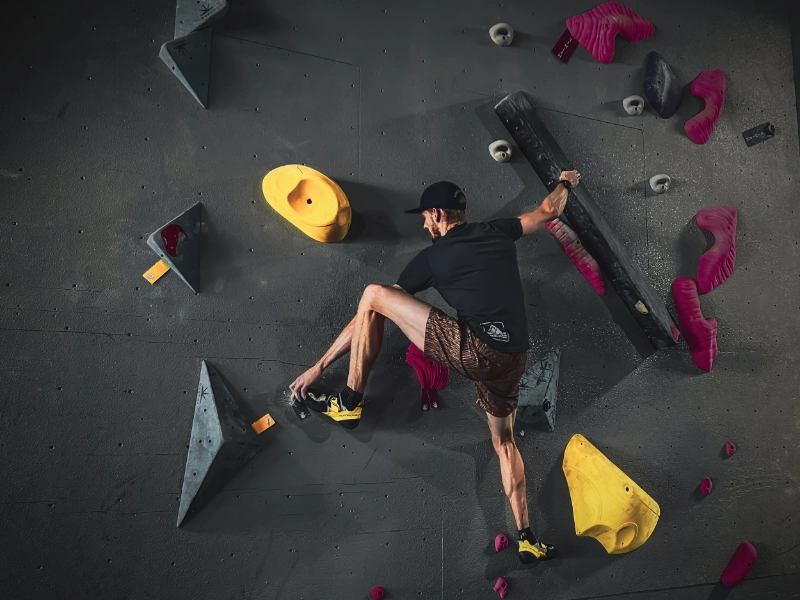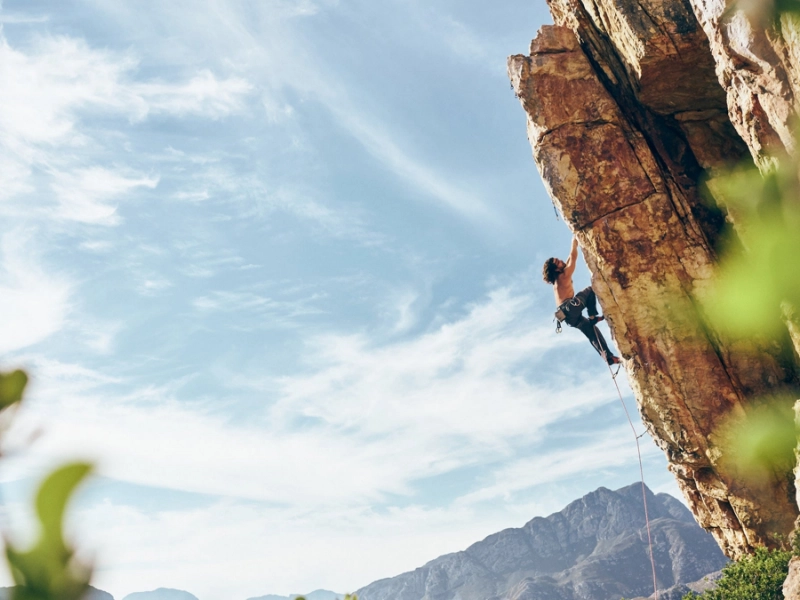Balance, strength, muscular endurance, and a high level of cardiorespiratory fitness are necessary for climbing. An appropriate off-the-wall training program that cultivates these attributes will improve climbing performance. Although it's necessary to use weights when climbing, many climbers also run and engage in other cardiovascular exercises. Arranging these activities in a way that allows the body to recuperate in between is crucial.

 Climbing is a full-body sport that requires a combination of muscular endurance and strength. You can climb more quickly and for longer periods of time if your training programme includes both aerobic and cardiovascular exercises.
When working out your upper body, concentrate on high-repetition, low-resistance exercises that imitate climbing motions (e.g., bear crawls, YTWL, air squats, and fingertip pushups). Work your way through these exercises in a circuit style, taking a double-time break after each set.
Exercises for the legs and core are also beneficial for climbing. Your core gets stronger with leg lifts and crunches, which aid in maintaining proper posture when climbing. Exercises for the legs also prevent the dreadful calf cramps that so many climbers experience.
It's crucial to keep in mind that a good workout involves the neurological system in addition to the muscles. Like muscles, your CNS also needs rest and recuperation. Keeping up with a thorough stretching regimen and creating a schedule for your gym sessions are the best ways to regulate your central nervous system and prevent burnout.
Climbing is a full-body sport that requires a combination of muscular endurance and strength. You can climb more quickly and for longer periods of time if your training programme includes both aerobic and cardiovascular exercises.
When working out your upper body, concentrate on high-repetition, low-resistance exercises that imitate climbing motions (e.g., bear crawls, YTWL, air squats, and fingertip pushups). Work your way through these exercises in a circuit style, taking a double-time break after each set.
Exercises for the legs and core are also beneficial for climbing. Your core gets stronger with leg lifts and crunches, which aid in maintaining proper posture when climbing. Exercises for the legs also prevent the dreadful calf cramps that so many climbers experience.
It's crucial to keep in mind that a good workout involves the neurological system in addition to the muscles. Like muscles, your CNS also needs rest and recuperation. Keeping up with a thorough stretching regimen and creating a schedule for your gym sessions are the best ways to regulate your central nervous system and prevent burnout.
 To get the most out of your climbing and training sessions, you should include a recovery workout in your gym or crag programme. After climbing, engaging in low-intensity activity will improve blood flow to the muscles, facilitating the removal of lactic acid and other waste products that accumulate during the ascent.
For example, if you walk or jog after around 15 minutes after climbing a long, juggy route, or if you do some gradual climbing, your body will recover faster. Similar to this, increasing your centre of gravity through antagonistic activities like pushups and reverse wrist curls will also help you climb more efficiently.
For faster muscle glycogen resynthesis, Horst also suggests having a protein and carbohydrate drink within two hours of your climbing workout. He points out that since liquid protein mixes more readily with carbohydrates, the process will go more quickly. It will also reduce the risk of post-climb pain.
To get the most out of your climbing and training sessions, you should include a recovery workout in your gym or crag programme. After climbing, engaging in low-intensity activity will improve blood flow to the muscles, facilitating the removal of lactic acid and other waste products that accumulate during the ascent.
For example, if you walk or jog after around 15 minutes after climbing a long, juggy route, or if you do some gradual climbing, your body will recover faster. Similar to this, increasing your centre of gravity through antagonistic activities like pushups and reverse wrist curls will also help you climb more efficiently.
For faster muscle glycogen resynthesis, Horst also suggests having a protein and carbohydrate drink within two hours of your climbing workout. He points out that since liquid protein mixes more readily with carbohydrates, the process will go more quickly. It will also reduce the risk of post-climb pain.
 A rest day is important for more than just physical recuperation, because climbing puts a lot of strain on your muscles. It also gives your body time to assimilate and deal with the stress of the activity. You'll be able to avoid overtraining, which is a major cause of strength and endurance loss.
You can increase your aerobic endurance by working out at a lesser intensity on your rest days. This can include a leisurely run or a low-intensity aerobics session. Just be sure to be deliberate about it by marking these days on your paper or digital calendar.
Some antagonistic movements, such as pushups or dips, can be included to help prevent injuries and imbalances of the muscles, including overuse shoulder soreness. While workouts like Is, Ys, and Ts with a theraband or light weights will strengthen your finger tendons, core work like planks and leg lifts can increase your climbing balance and power. Lastly, adding in some breathing exercises can help you better control your breathing during a lengthy crux sequence and maintain your composure on the wall.
A rest day is important for more than just physical recuperation, because climbing puts a lot of strain on your muscles. It also gives your body time to assimilate and deal with the stress of the activity. You'll be able to avoid overtraining, which is a major cause of strength and endurance loss.
You can increase your aerobic endurance by working out at a lesser intensity on your rest days. This can include a leisurely run or a low-intensity aerobics session. Just be sure to be deliberate about it by marking these days on your paper or digital calendar.
Some antagonistic movements, such as pushups or dips, can be included to help prevent injuries and imbalances of the muscles, including overuse shoulder soreness. While workouts like Is, Ys, and Ts with a theraband or light weights will strengthen your finger tendons, core work like planks and leg lifts can increase your climbing balance and power. Lastly, adding in some breathing exercises can help you better control your breathing during a lengthy crux sequence and maintain your composure on the wall.